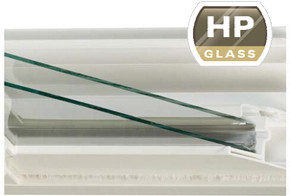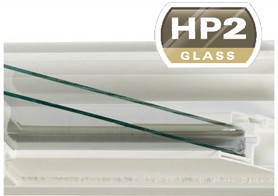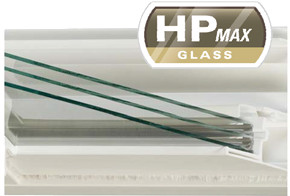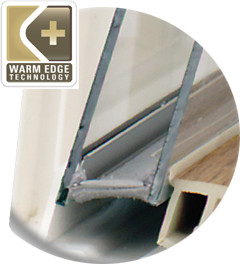
High Performance Glass
- Double Pane Insulated Glass
- One Low-E Coating
- One Chamber of Argon Gas
- Warm Edge Spacer
- Optional Advanced Easy Clean Glass

High Performance2+ Glass
- Double Pane Insulated Glass
- Two Low-E Coatings (One on Interior Surface)
- One Chamber of Argon Gas
- Warm Edge Spacer
- Optional Advanced Easy Clean Glass

High Performance2Max Glass
- Triple Pane Insulated Glass
- Two Low-E Coatings
- Two Chambers of Argon Gas
- Warm Edge Spacer
- Optional Advanced Easy Clean Glass
Double Pane Insulated Glass:
Dual pane insulated glass consists of two panes of glass that are sealed together resulting in one dead air space in between the glass – the dead air space is an insulator. Our overall insulated glass measures 7/8” thick. A dead air space between the glass of 3/4” or greater is optimal for allowing air to act as an insulator. Having dual pane glass greatly reduces heat and sound transfer.
Triple Pane Insulated Glass:
Triple pane insulated glass consists of three panes of glass that are sealed together resulting in two dead air spaces in between the glass. Triple pane glass reduces the heat and sound transfer more than dual pane insulated glass.
Low-E:
Low-E stands for low emissivity. It is a very thin metallic coating that allows the sun’s light to pass through the insulating glass, but, at the same time reflects radiant heat back toward its source. It helps keep your home warmer in the winter by trapping radiant heat in your home. And it helps keep your home cooler in the summer by blocking radiant heat from entering your home. The low-e glass provided in your windows results in minimal visible darkening which has been a common problem with some low-e glass. Also it minimizes interior glare, reducing eyestrain and making it easier to watch television or look at a computer screen when bright sunlight fills a room.
Argon Gas:
Argon is a nontoxic, nonreactive, clear, and odorless gas . It is put in the air space(s) of your dual and triple pane insulated glass. Argon gas is less heavy and slower-moving than air and thus minimizes convection currents within the dead air space. Conduction through the gas is reduced, and the overall transfer of heat is reduced.
Warm Edge Spacer:
The panes of glass in dual and triple pane insulating glass are held together by a spacer. The spacer runs along the entire perimeter of your insulating glass. The edge of the glass is the coldest part of any window. So the spacer is very important. Warm Edge Technology reduces thermal transfer at the edge of the glass by utilizing a unique U-shaped channel to separate the glass panes and interrupt the natural flow of heat to cold. It flexes with glass expansion and contraction to ensure a strong seal for the life of the window.

Optional Advanced Easy Clean® Glass is a remarkable advancement in glass design that eliminates frequent exterior window cleaning. Windows and doors with special Easy Clean Glass require less effort to clean than windows with ordinary glass.

Fade Protection:
Safeguard your valuable interiors with HP glass options that offer the ultimate in superior fade protection. Your favorite photograph, your child’s artwork, even your furniture and carpet can fade or discolor after repeated exposure to direct sunlight. Our window's HP glass provides a sunscreen for your house, blocking damaging ultraviolet rays without noticeably reducing the light coming inside. Depending on your custom glass option, 99% of damaging UV rays can be blocked
Extra Sound Deadening Glass:
This glass option helps to reduce exterior noise and provide STC (Sound Transmission Class) values as high as 34. An STC rating provides a standard industry-accepted method for comparing the sound reduction effectiveness of various glass options and window and door systems. The higher the STC number, the greater the resistance to sound transmission
Obscure Glass:
Optional obscure glass obscures your view through the glass. It transmits light but does not allow a view of objects on the other side. It obscures your view from the outside of your home looking in, and from the inside of your home looking out. It is most commonly used in bathrooms and is sometimes referred to as frosted glass.
Tempered Glass:
Optional tempered glass is hardened ‘safety’ glass which is not only less likely to break on impact, but when it does break it typically reduces to smaller, more rounded ‘crumbles’ that are less likely to cause harm. Tempered glass is standard in all our sliding doors. Most windows do not require tempered glass. Check your local building codes for tempered glass requirements.

 317-353-3000
317-353-3000



